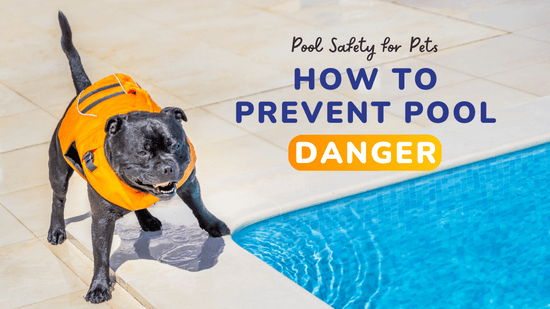Pool Safety Tips for Your Water-Loving Dog
)
Many dogs love the water, especially during warm weather when swimming or playing in the pool is a fun and refreshing activity. However, as much as your dog may enjoy splashing around, it's essential to prioritise safety in the pool to avoid accidents and health risks. This guide offers practical tips to ensure that your water-loving dog stays safe, healthy, and happy during every swim.
Why Swimming is Great for Dogs
Swimming is an excellent form of exercise for dogs, as it provides a low-impact workout that is easy on their joints, especially for older or arthritic dogs. The cool water can also be a relief for pets who suffer from heat stress in warmer months. Many dogs also enjoy the mental stimulation and sense of freedom that swimming provides, making it a great bonding experience for you and your pet.
However, despite the many benefits of swimming, there are essential safety measures that every pet owner should follow to ensure that their dog stays safe in the water.
1. Ensure Your Dog is a Confident Swimmer
Not all dogs are natural swimmers, so it's important to assess your dog’s comfort and ability in the water before letting them take the plunge. Start with shallow water and allow your dog to gradually get used to the sensation of floating and paddling. If your dog is hesitant, never force them into the water, as it can cause anxiety or fear.
Some dog breeds are naturally better swimmers than others. For instance, retrievers, spaniels, and poodles are usually strong swimmers, while breeds with heavy, broad chests or short legs, like bulldogs or dachshunds, may struggle to keep afloat. In these cases, a dog life vest might be essential to help them stay safe in the water.
2. Use a Dog-Friendly Pool
If you're using a pool for your dog to swim in, it’s essential to ensure that the pool is safe and pet-friendly. Chlorine in pools can be harsh on your dog’s skin and fur, so it’s a good idea to rinse them off after each swim to remove chemicals. Also, ensure the pool’s sides aren’t too slippery for your dog to get out easily. Adding steps or a ramp can give your dog a safe way to exit the pool without risk of injury.
Always supervise your dog in the pool, even if they’re an experienced swimmer. Keep in mind that dogs can tire quickly, and the pool may not have clear markings to show depth or entry/exit points, which could cause confusion or panic.
3. Teach Your Dog to Exit the Pool Safely
Teaching your dog to exit the pool is crucial for their safety. Dogs can panic if they don’t know how to get out of the water, so it’s important to train them to use a ramp or pool steps. Repeatedly show them the exit points, and use treats or encouragement to make the process enjoyable and rewarding. Some dogs will instinctively try to exit through the side, but others may need a bit more guidance.
If your pool has no designated entry or exit points, consider adding a dog-friendly ramp that allows them to climb out easily.
4. Supervise Your Dog at All Times
Even the best swimmers need supervision, especially in a pool. Dogs can become tired, disoriented, or distracted, which may lead to accidents. Always stay within arm's reach of your dog while they’re in the water, particularly if they’re new to swimming or if you're in a large pool.
If your dog starts to tire, get them out of the water immediately and give them a chance to rest. Swimming can be exhausting, and dogs may not recognise their limits, especially when they're having fun.
5. Keep Hydrated
Swimming can be physically demanding, and just like humans, dogs can get dehydrated, especially when they’re exercising in the heat. Make sure your dog has access to fresh water before and after their swim. Always encourage them to take breaks and drink water to replenish their fluids, particularly if they’ve been swimming for an extended period.
6. Check for Pool Chemicals and Cleanliness
Before allowing your dog to swim, check the water’s chemical balance. While a well-maintained pool is essential for both human and pet safety, the chemicals used to treat pools can irritate your dog’s skin, eyes, and respiratory system. Ensure that the water is free of algae or debris that could pose a risk to your pet’s health.
If your dog has sensitive skin, consider using a special dog-friendly pool or installing a filtration system that is gentler on their coat and skin
7. Know the Signs of Water Intoxication
Just like humans, dogs can experience water intoxication, a condition that occurs when a dog swallows too much water. Symptoms of water intoxication include vomiting, bloating, loss of coordination, and lethargy. If you suspect your dog may have ingested too much water, contact your vet immediately.
To reduce the risk of water intoxication, monitor how much water your dog drinks during their swim, and be sure to take regular breaks.
8. Use Dog Life Jackets When Necessary
If you’re swimming in an area with rough water or currents, or if your dog is not a strong swimmer, consider using a dog life jacket. A life jacket will help keep your dog buoyant and safe, particularly if they tire or are caught in a current. Choose a life jacket that fits snugly and comfortably, ensuring that your dog can still move freely and swim.
9. Inspect Your Dog for Pool-Related Injuries
After swimming, it’s important to check your dog for any injuries, such as cuts or abrasions from the pool’s edge, scratches from rough surfaces, or ear infections caused by water exposure. Always dry your dog thoroughly after swimming, paying particular attention to their ears, as water can get trapped inside and lead to infections.
10. Poolside Safety
If your dog enjoys spending time by the pool, make sure the area around the pool is safe. Ensure that there are no objects they can ingest, like small toys or pool accessories, that could cause choking or intestinal blockages.
If you have a garden or outdoor area that leads to the pool, consider installing a pet-safe fence or barrier to prevent your dog from accidentally wandering into the pool unsupervised.
Swimming is a fantastic way for your dog to exercise, cool off, and have fun. However, as with all activities, it’s important to take the necessary precautions to ensure their safety. By following these tips, you can help your dog enjoy the water while keeping them safe from harm. Whether it’s in a private pool, at the beach, or at a dog-friendly swimming hole, always remember that your pet’s well-being comes first.
At Cammeray Veterinary Hospital, we care about your pet’s health and safety in every environment. If you have any concerns about your dog’s swimming habits or health, don’t hesitate to reach out for professional advice and guidance.
| Tags:Pet Safety |
)
